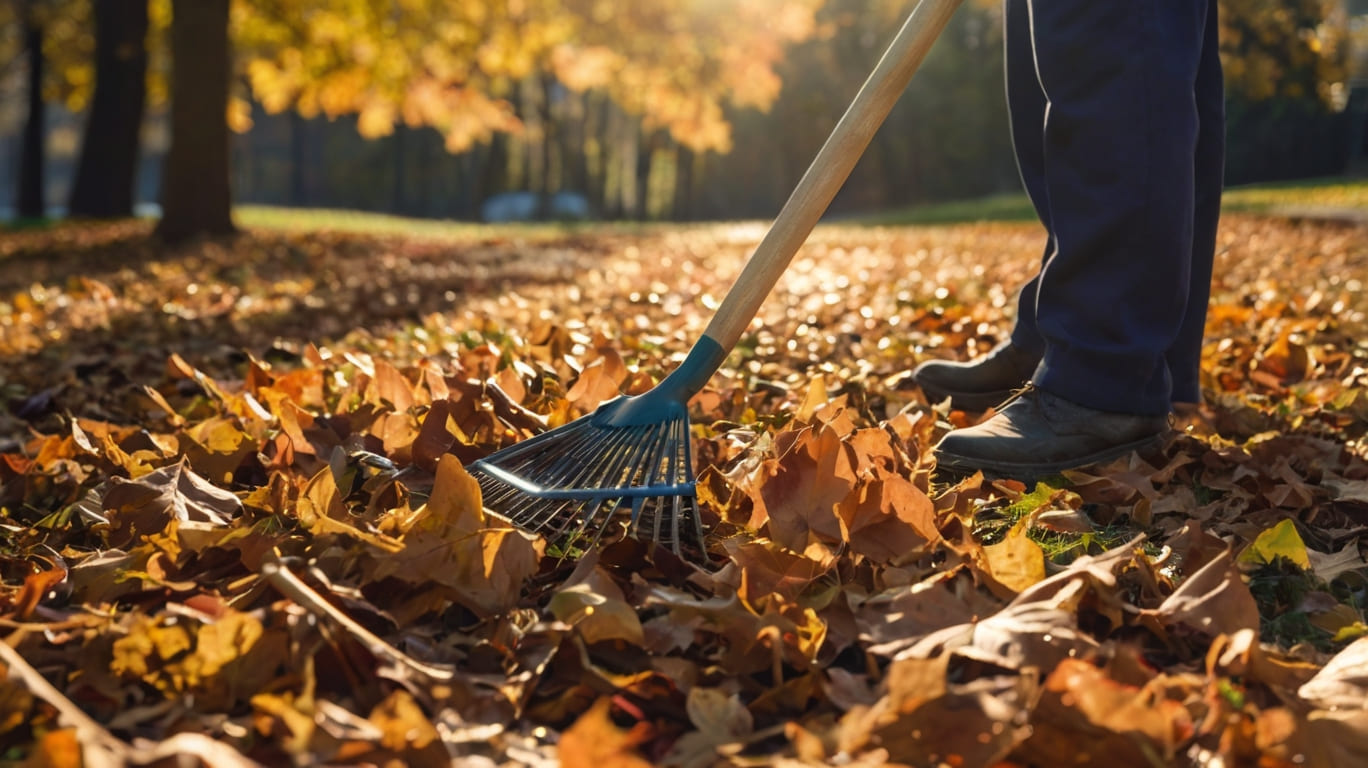
Gardening is all about using the right tool for the job. Whether you’re just starting out or already have a green thumb, this guide will help you understand the essential garden tools that can transform your garden work—from clearing leaves to precise weeding. If you’re feeling ready to expand your toolkit, there are a few other rakes and hoes worth considering.
Disclaimer: This site does not have any affiliate links. All recommendations are my own.
In this article
Rakes – Clearing, Leveling, and Specialized Lawn Care
Rakes come in various types, each designed to handle different tasks in your garden. Whether you’re raking leaves, leveling soil, or tackling tougher debris, here’s a breakdown of the rakes that can help.

Metal Rake
A strong metal rake is a go-to for heavy-duty work. Its metal tines allow you to break up compacted soil, move rocks, and handle tough debris. If you’re working with harder materials, a metal rake is essential.

Thatch Rake
Ever notice that thick, dead layer of grass and debris in your lawn? That’s called thatch, and it can block sunlight and nutrients from reaching your grass.
A thatch rake, with its sharp tines, is specifically designed to remove it. It’s a bit of a workout, but the results—a healthier, greener lawn—are well worth it.

Garden Rake
Sometimes called a bow rake, the garden rake is the workhorse of the rake family. With short, strong tines and a flat head, it’s ideal for leveling soil, preparing garden beds, and breaking up clumps. This versatile rake is perfect for gardeners who want one reliable tool for multiple tasks.
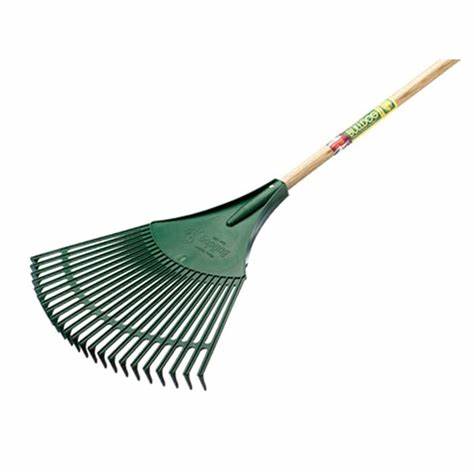
Plastic Rake & Plastic Leaf Rake
Plastic rakes, especially leaf rakes, are lightweight and gentle on delicate lawns. They’re ideal for everyday leaf cleanup without tearing up grass or flowerbeds. For regular yard maintenance, a plastic leaf rake is a must-have, especially in the fall.

Landscaping Rake
A landscaping rake is a heavy-duty tool with a broad head and long tines, designed for leveling soil, gravel, and other materials over larger areas. If you’re preparing a garden bed or spreading materials, this rake will save you time and energy.

Shrub Rake & Shrub Hand Rake
A shrub rake has a narrow head, making it ideal for working in tight spaces or around shrubs. It’s a must-have if you have densely planted areas where a larger rake won’t fit. A shrub hand rake is a smaller, hand-held version of the shrub rake. Perfect for working around potted plants, flower beds, or tight garden areas, it provides precise control when clearing around delicate plants.

Heavy-Duty Landscaping Rake
For the biggest projects, a heavy-duty landscaping rake is essential. Built to withstand tough tasks, it’s excellent for moving large amounts of soil, gravel, or other dense materials in larger landscapes.

Stone Rake (Rock Rake)
This rake has strong tines capable of handling rocks, stones, and other heavy debris. If your soil is rocky or you’re dealing with areas with gravel, a stone rake is invaluable for managing tougher terrain.

Adjustable Leaf Rake
An adjustable leaf rake allows you to change the width of the rake head, giving you versatility for different spaces. Widen it for open areas or narrow it down to work around plants and in flower beds.
Hoes – Essential Tools for Weeding and Soil Prep
Hoes are another staple in any gardener’s toolkit, especially when it comes to tackling weeds and preparing soil. Let’s look at the varieties that are most effective in an indoor or outdoor garden setup.

Weeding Hoe
A weeding hoe is sharp and designed to slice weeds right at the surface. It’s perfect for keeping pesky weeds under control without disturbing surrounding plants. If you’re like me and can’t stand the sight of weeds popping up in your beds, this is the tool you’ll want by your side.
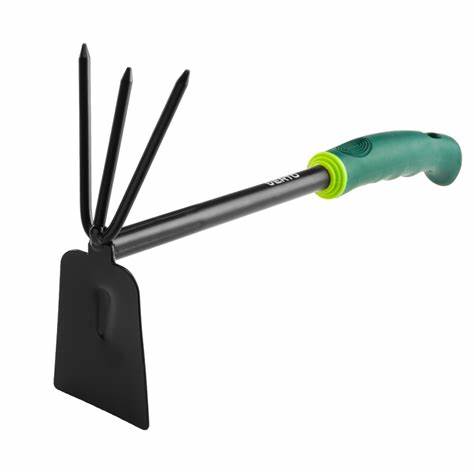
Small Garden Hoe
Compact and easy to handle, the small garden hoe is perfect for tighter spaces or delicate beds. It allows for precision, letting you dig or weed close to plants without damaging their roots. If you have raised beds or container plants, a small garden hoe is a fantastic choice for precise soil work.

Warren Hoe (or Pointed Hoe)
For gardeners who love to grow in rows, the Warren Hoe is a game-changer. Its pointed, triangular blade is ideal for digging furrows or small trenches, making it perfect for planting. This tool is also excellent for breaking up soil clumps, which helps prepare your garden bed for planting.

Stirrup Hoe (or Scuffle Hoe)
The stirrup hoe, with its unique looped blade, is made for easy, shallow weeding. You simply push and pull it back and forth, slicing weeds at the surface without disturbing the soil below. It’s perfect for regular garden upkeep, helping you quickly manage weeds before they take over.

Half-Moon Garden Edger
This specialized hoe has a half-moon-shaped blade designed to create clean, defined edges along garden beds, paths, or walkways. It’s ideal for keeping your garden’s borders tidy and visually appealing.

Cape Cod Weeder
A Cape Cod weeder is a small, L-shaped hoe ideal for precision weeding around tight spaces and in raised beds. It’s easy to handle and allows for detailed work without disturbing nearby plants.

Eye Hoe (Grub Hoe)
An eye hoe, or grub hoe, has a thick, sturdy blade that’s fantastic for breaking up tough soil, especially in rocky or compacted areas. It’s essential for gardeners working in challenging soil conditions.
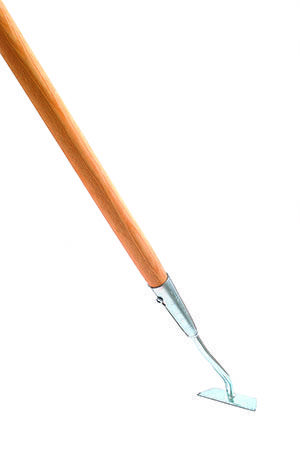
Collinear Hoe
The Collinear Hoe is a favorite among gardeners who need precision weeding in tight rows or densely planted areas.
One of the major advantages of the collinear hoe is its ergonomic design. The tool is long-handled, so you can use it while standing upright, which means less bending and reduced strain on your back. This makes it ideal for gardeners with larger plots who need to weed frequently but want to avoid the physical strain of more traditional, bent-over weeding methods.
When using the collinear hoe, you simply slide the thin blade just under the soil surface, cutting weeds off at the root level.
Weeding Forks – Targeted Weed Removal with Precision
Weeding forks are small but mighty, designed to dig deep and tackle stubborn weeds from the roots. They’re perfect for anyone tired of fighting the same weeds over and over.
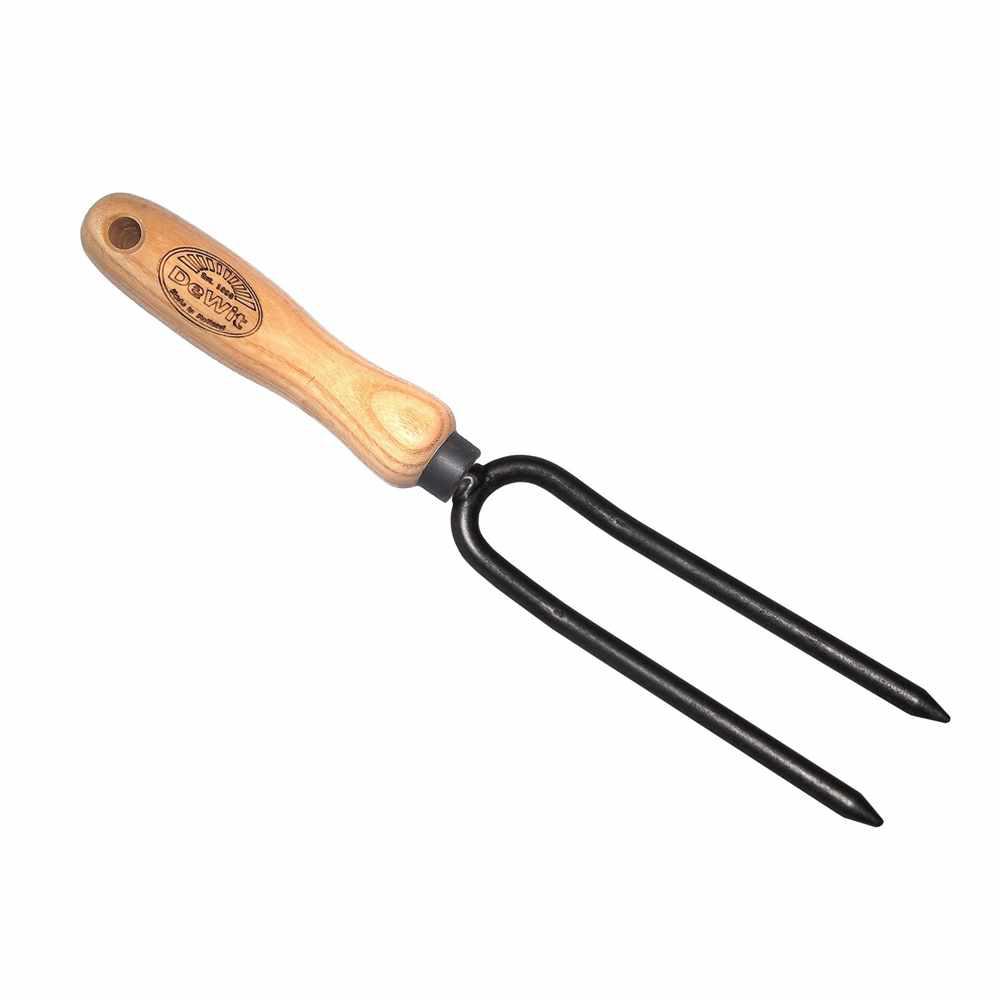
Standard Weeding Fork
A weeding fork, usually with two or three tines, allows you to dig down and get to the roots of pesky weeds. It’s incredibly satisfying to pull out an entire weed, roots and all, with one easy twist of this tool. Plus, it’s fantastic for aerating compact soil around small plants.

3-Prong Weeding Fork
If you need a bit more stability and digging power, a 3-prong weeding fork is a great choice. Its extra tine helps with balance, letting you tackle tougher soil and more deeply rooted weeds. It’s also perfect for looser soil or garden beds with densely planted crops.
RELATED: 18 Most Useful Gardening Tools to Own [Tried and Tested]
Other Handy Tools for Your Garden
If you’re feeling ready to expand your toolkit, there are a few other rakes and hoes worth considering. These specialized tools can make certain tasks quicker and easier.

Hand Trowel
A hand trowel is a must-have for any gardener. This small, handheld tool is perfect for tasks like planting, transplanting, and digging small holes. A sturdy, well-made hand trowel with a comfortable grip is essential for detailed work in flower beds, container gardening, or any space where larger tools might be too bulky. Look for one with a sharp, rust-resistant blade and an ergonomic handle for comfort.

Garden Scissors or Pruning Shears
Pruning shears (or secateurs) are essential for keeping plants healthy and well-shaped. They’re great for cutting back stems, trimming dead or damaged foliage, and harvesting herbs or flowers.
Garden scissors are a bit smaller and easier to handle for delicate pruning jobs, like trimming herbs or shaping small plants. Both tools help maintain a neat, healthy garden.

Garden Knife (Hori-Hori Knife)
The Hori-Hori knife, also known as a soil knife, is a versatile tool with a sharp, serrated blade. Originating from Japan, this knife is excellent for digging, cutting roots, and even weeding. It’s perfect for planting bulbs, slicing through tough roots, or dividing perennials. Many gardeners find it indispensable due to its versatility, making it an excellent multi-purpose addition to your toolkit.

Soil Scoop
A soil scoop is shaped like a large spoon and is incredibly handy for transferring soil, compost, or fertilizer into pots or small garden beds. Its deep, curved shape allows you to scoop larger amounts of soil than with a hand trowel, making it an ideal tool for container gardening or indoor plants. Some models even come with measurements marked on the inside, which can be helpful for potting soil mixes.

Garden Fork (Digging Fork)
A garden fork is an excellent tool for turning soil, breaking up compacted earth, and aerating your beds. It’s great for loosening soil before planting, lifting clumps of weeds, or working in compost. A digging fork with sturdy, strong tines is especially useful in tougher soils or areas with lots of roots and rocks.

Garden Kneeler or Padded Kneeling Pad
If you’re doing a lot of work close to the ground, like planting or weeding, a garden kneeler or padded kneeling pad can make things much more comfortable. Many garden kneelers are designed to flip over and double as a small seat, providing extra support. A good kneeling pad reduces strain on your knees and makes prolonged ground work easier.

Watering Wand
For delicate plants and hanging baskets, a watering wand is a fantastic tool that provides a gentle flow of water, reaching areas that might be hard to access with a regular watering can or hose nozzle.
Many models come with an adjustable head so you can control water pressure, making it easier to provide the right amount of water without disturbing soil or delicate foliage.
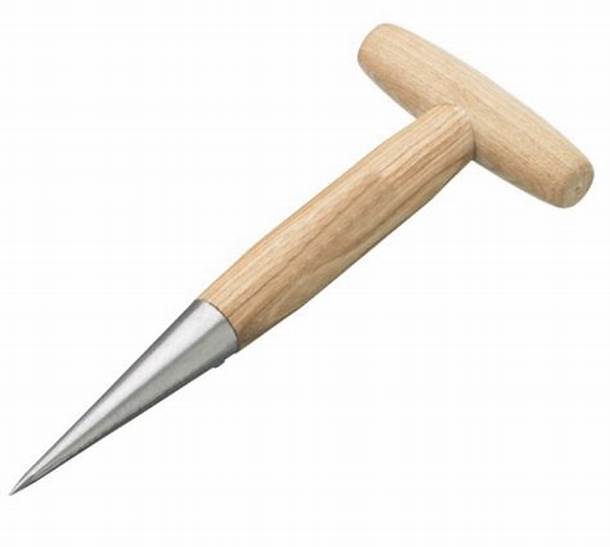
Garden Dibber (Dibble)
A dibber (or dibble) is a pointed tool used for making holes in the soil to plant seeds, seedlings, or bulbs. It’s especially helpful when planting in rows or making consistent holes. Some dibbers even come with depth markings, which is useful for planting bulbs or seeds at the right depth.

Garden Spade
A spade is a small, flat-bladed shovel that’s perfect for digging, edging, and dividing plants. Its sharp, square blade is ideal for slicing through roots, creating borders, and working in raised beds. Unlike a round-pointed shovel, a garden spade is more precise, making it useful for cutting straight edges around beds or pathways.

Wheelbarrow or Garden Cart
If you’re moving a lot of soil, compost, plants, or heavy tools, a wheelbarrow or garden cart is incredibly helpful. It reduces the strain on your back, saving you multiple trips by allowing you to transport everything in one go. Garden carts are often easier to maneuver on flat surfaces, while traditional wheelbarrows handle uneven terrain better.

Garden Hose with Reel and Spray Nozzle
A high-quality garden hose with a spray nozzle and a hose reel can save you time and effort. The reel keeps the hose neatly stored and prevents tangling, while the spray nozzle gives you control over water flow and pressure. This setup is perfect for efficiently watering large gardens or raised beds.

Soil Moisture Meter
A soil moisture meter is a small but highly useful tool, especially for indoor or container gardening. It helps you gauge the moisture levels in the soil, which is critical for plants that are sensitive to over- or under-watering. With a quick check, you’ll know whether your plants need more or less water, preventing root rot or dehydration.

Hand Cultivator
A hand cultivator is a small, handheld tool with three or four curved tines, used for loosening soil and mixing in fertilizers or compost. It’s particularly useful in raised beds, pots, or other small areas. A hand cultivator lets you gently aerate the soil, which helps roots access oxygen and nutrients.

Garden Gloves
A durable pair of garden gloves is essential for any gardening task. They protect your hands from dirt, cuts, and blisters and are especially useful when working with thorny plants or rough soil. Look for gloves that are water-resistant but still breathable for comfort during longer tasks.
These additional tools are highly useful and can make a big difference in the ease and enjoyment of gardening.
Choosing the Right Tools for Your Garden
When selecting garden tools, consider your garden size, soil type, and the specific tasks you need to perform. For example, if you have a large lawn with lots of leaf debris, a plastic leaf rake or adjustable leaf rake can make cleanup fast and easy. If you’re dealing with rocky or compacted soil, a stone rake or eye hoe will help you manage the more challenging terrain. Each tool has its purpose, and having a selection of quality tools ensures you’re ready for any gardening task that comes your way.
Frequently asked questions
What rake is best for lawns with dense thatch?
A thatch rake is specifically designed for removing thatch, which can block water and sunlight from reaching grass roots. It’s a must-have if your lawn has thick thatch build-up.
Which rake should I use for gravel?
A stone rake (or rock rake) is perfect for handling gravel, rocks, and heavy debris. Its strong tines can handle tougher materials without bending.
Can I use a garden hoe in raised beds?
Yes. A small garden hoe or Cape Cod weeder is ideal for raised beds, as these tools offer precision and control in smaller spaces.
Is a landscaping rake necessary?
If you’re working on large landscaping projects, a landscaping rake will save you time and effort when spreading soil, gravel, or other materials over bigger areas. But for smaller gardens this is not necessary.
What’s the best tool for edging garden beds?
A half-moon garden edger is designed specifically for creating clean edges along garden beds, giving your garden a polished look.
With these tools at your side, you’ll be prepared for any gardening task, big or small. Each of these rakes, hoes, and weeding forks has a specific purpose, so investing in the right ones will save you time and effort in the garden.
The right tools make all the difference—happy gardening!
YOU MAY ALSO LIKE: The Best Eco-Friendly Gardening Tools







